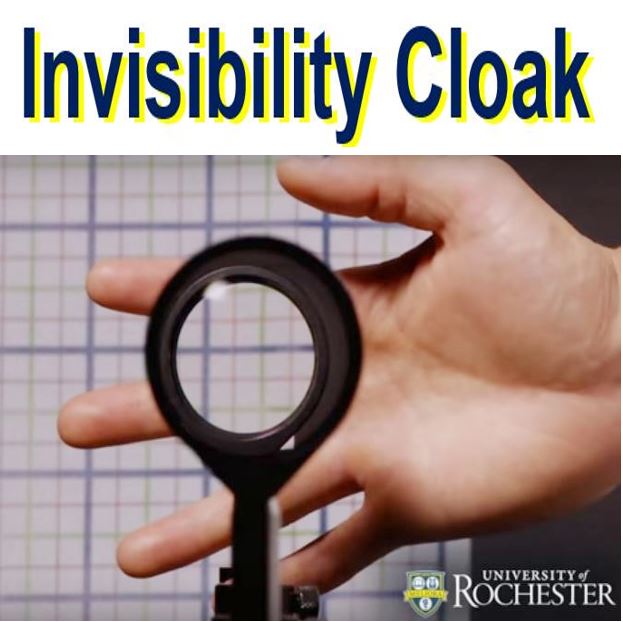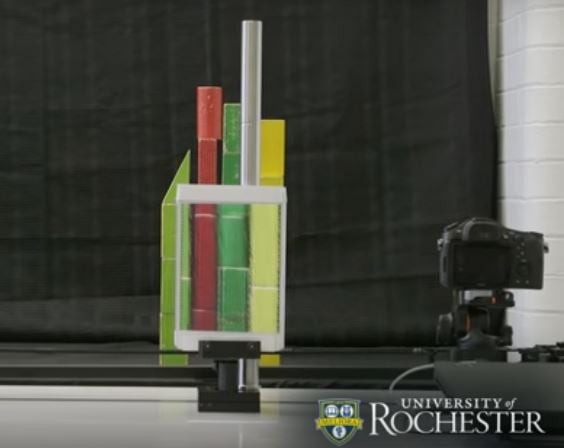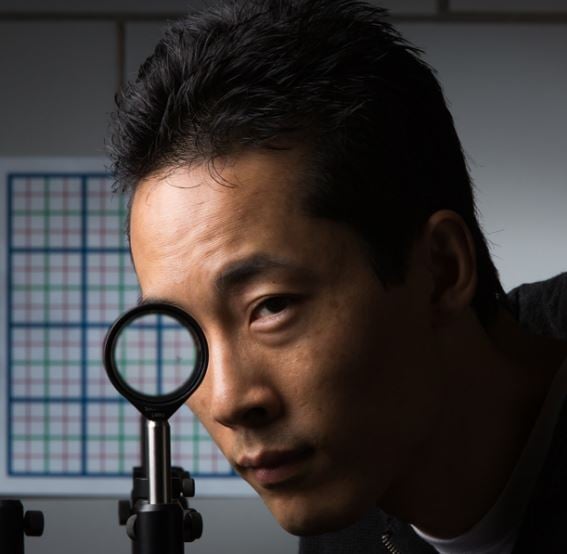An invisibility cloak, very similar to the one in the Harry Potter stories, really does work – it completely hides what it is cloaking so that all people see is what is behind, it, a team of scientists from the University of Rochester, New York state, showed.
They used the same mathematical framework as the Rochester Cloak, and were able use a flat screen display to extend how many angles the target object could be hidden from view.
Joseph Choi, From Rochester’s Institute of Optics and John Howell, from the same institute as well as the Institute for Quantum Studies, Chapman University in California, explained in the academic journal Optica (citation below) that their method lays out how cloaks of arbitrary shapes work from several different viewpoints.
 Where have two of his fingers gone? Scientists at the University of Rochester have already demonstrated how cloaking can be done with basic optics. (Image: rochester.edu)
Where have two of his fingers gone? Scientists at the University of Rochester have already demonstrated how cloaking can be done with basic optics. (Image: rochester.edu)
Cloaking devices may soon become available
The authors believe their method could soon be used with commercially-available digital devices.
The scientists have shown a proof-of-concept demonstration for such a setup, which is still significantly lower resolution than the almost perfect imaging that the Rochester Cloak lenses achieved.
However, as higher-resolution displays become available, which they are in increasing numbers, the ‘digital integral cloak’ they describe will continue improving.
The Rochester Cloak is great and offers a simple way of hiding something from view. However, it is limited by the very small range of angles, while cloaking a large object would require big and expensive lenses.
 Where has the vertical rod gone? In order to cover a wider range of angles and hide larger target objects, the scientists have developed a new method that uses digital display. (Image: YouTube)
Where has the vertical rod gone? In order to cover a wider range of angles and hide larger target objects, the scientists have developed a new method that uses digital display. (Image: YouTube)
By breaking up the data into different pieces, it is possible to use currently available digital cameras and digital displays, the authors explained.
New approach hides object from multiple angles
Howell and Choi used a camera to scan a background and then encoded the data in such a way that every pixel on a screen offered a unique view of a given point on the background for a given position of an observer.
By doing this for several views and using lenticular lenses – a sheet of plastic with an array of parallel, thin semi-cylindrical lenses – they could create several images of the background, each one corresponding to a viewer at a different position.
If the viewer moved from one side to the other, every part of the background moved accordingly, as if there were no screen there, ‘cloaking’ anything in between the screen and the background.
In the current system, it took Mr. Choi, a PhD student, and Prof Howell, his advisor, several minutes to scan, process and update the image on the screen – to update the background.
They should soon be able to do this in real-time, Choi explained, even if at lower resolution.
New approach cloaks moving objects
Their mathematical framework and proof-of-concept setup also shows how any object of a certain size can be cloaked, even if it is moving – as long as the shape of the object does not change or deform.
 Joseph Choi’s eye cloaked. When she was writing the Harry Potter stories, J.K. Rowling never imagined that she would live to see a real cloaking device. (Image: rochester.edu)
Joseph Choi’s eye cloaked. When she was writing the Harry Potter stories, J.K. Rowling never imagined that she would live to see a real cloaking device. (Image: rochester.edu)
To do this, one side of the target object (to be cloaked) would be covered in an array of sensors – effectively several cameras – and the other side in pixels with minuscule lenses over them.
Howell’s and Choi’s method could then be used to identify which sensors need to feed into which pixels to show the background, as if there were no object there. A similar trick – but for one viewing angle only – has been used in advertising.
However, by using the Rochester group’s set up, for example a car could be made invisible to observers from several positions, not just one individual at a predetermined position.
In an Abstract which describes the main article in the journal, the scientists wrote:
“Experimentally, we demonstrate a two-dimensional (2D) planar, ray optics, digital cloak by using lenticular lenses, similar to “integral imaging” for three-dimensional (3D) displays.”
“Theoretically, this can be extended to a good approximation of an ‘ideal’ 3D cloak. With continuing improvements in commercial digital technology, the resolution limitations of a digital cloak can be minimized.”
Citation: “Digital integral cloaking,” Joseph S. Choi and John C. Howell. Optica, Volume 3, Issue 5, pages 536-540. May 2016. DOI: 10.1364/OPTICA.3.000536.
Video – The Rochester Digital Cloak
Using the same mathematical framework as for the Rochester Cloak, Choi and Howell have been able to use flat screen displays to extend the range of angles that can be hidden from view.

